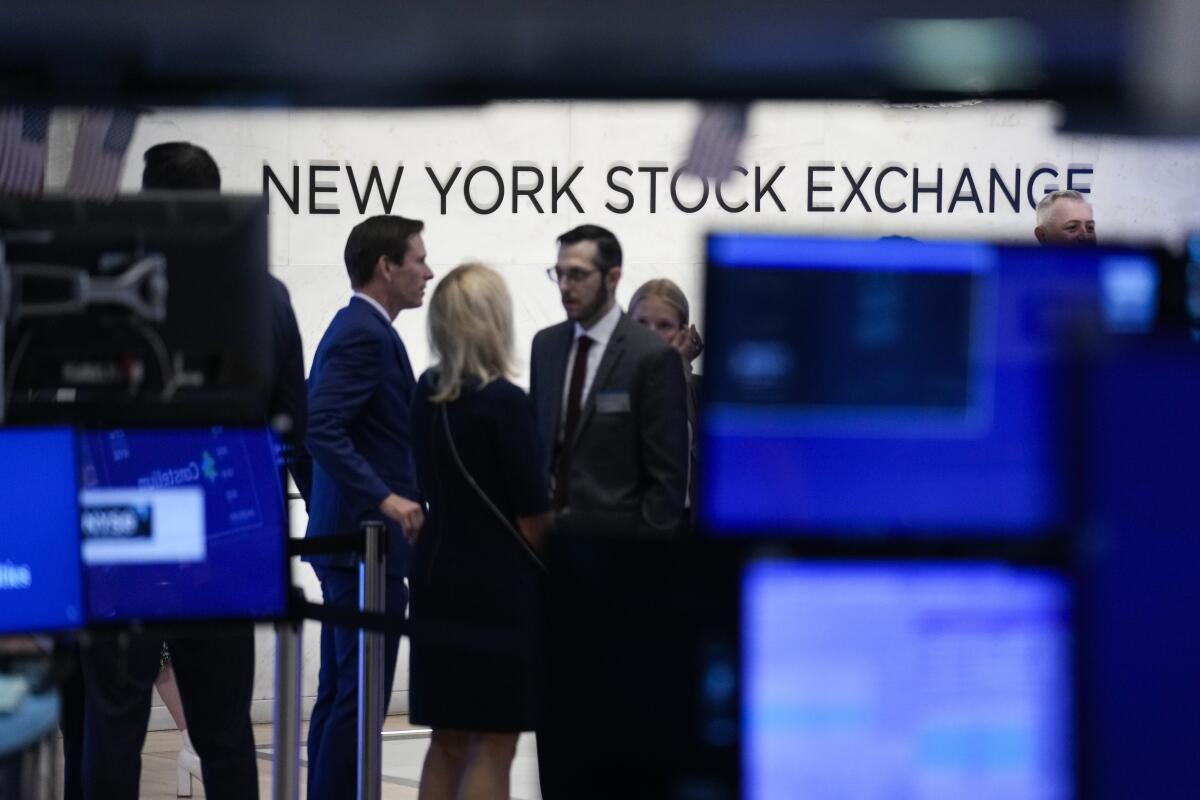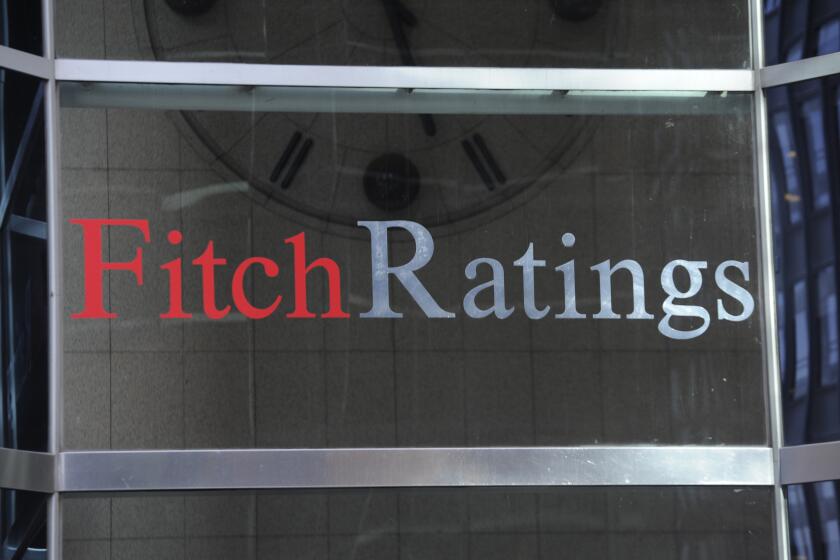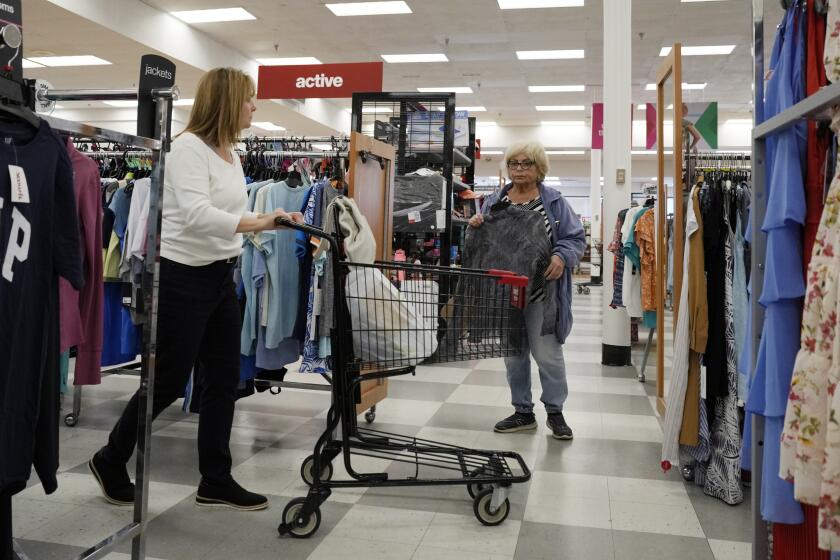Stocks on Wall Street tumble to their worst loss in months

- Share via
Wall Street tumbled to its worst drop in months Wednesday as its torrid rally — which critics called overdone — lost more momentum.
The Standard & Poor’s 500 index sank 1.4%, its sharpest tumble since April. This was the second straight loss for the index after it hit a 16-month high last week.
The Dow Jones industrial average slid 1%, and the Nasdaq composite dropped 2.2%.
Prices were mixed in the bond market after Fitch Ratings cut the credit rating of the U.S. government. The repeated standoffs in Congress about whether to allow a default on the U.S. debt were just some of the reasons for Fitch’s cut. The downgrade strikes at the core of the global financial system because U.S. Treasurys are considered some of the safest possible investments.
Fitch Ratings downgraded the U.S. credit rating, citing an expected increase in government debt and a “steady deterioration in standards of governance.”
Fitch’s move follows a similar one by Standard & Poor’s in 2011, one that coincided with a European debt crisis, helping to cause stocks and bonds around the world to swing violently. So far, this most recent downgrade has caused less drama across markets.
Although the downgrade highlights how much debt the U.S. government has and the big challenges it faces in how to pay for Social Security, Medicare and other expenses, none of that is news for investors.
“Fitch’s downgrade is much ado about nothing,” said Brian Jacobsen, chief economist at Annex Wealth Management. “Yes, it’s good to call out the fiscal situation, but when a country only issues debt in its own currency, the credit rating is irrelevant. Every investment fund I’ve looked at specifies that U.S. Treasury securities are allowed investments, regardless of what a credit rating agency might think.”
The big issues for Wall Street remain whether the economy can avoid a long-predicted recession, as hoped, and what’s happening with corporate profits. And reports on both those questions came in mixed on Wednesday.
That offered fodder for critics who say investors were too quick to buy into the belief that a soft landing is surely ahead for the economy. They’ve been saying Wall Street rallied too much, too quickly this year. Analysts said some of Wednesday’s selling could be investors locking in profits made during the S&P 500’s 19.5% run for the year through July.
One report suggested that hiring in the private sector remains much stronger than economists expected, even if it slowed from the prior month. A job market that remains solid could keep a lid on worries about a possible recession. But investors also fear a too-strong reading, which could convince the Federal Reserve that too much upward pressure still exists on inflation.
Despite more than a year of widespread warnings that a recession was near, America’s economy is, if anything, accelerating.
The Fed has already yanked its federal funds rate higher at tremendous speed in hopes of undercutting inflation. High rates do that by slowing the economy bluntly, but that risks causing a recession and hurts prices of investments along the way.
Inflation has been cooling since last summer’s peak, and the rising hope on Wall Street had been that the Fed won’t hike rates anymore and could even begin cutting them next year.
Wednesday’s stronger-than-expected jobs report from ADP could be a signal of what Friday’s more comprehensive report from the U.S. government will say. Fed Chair Jerome H. Powell has highlighted Friday’s numbers as a big influence on the central bank’s next move in September.
Higher rates tend to hurt technology and other high-growth stocks in particular, and major tech stocks helped drag the market lower Wednesday. Microsoft, Nvidia and Amazon shares all fell more than 2.5% and were some of the heaviest weights on the S&P 500.
Generac Holdings, which sells generators and other power products, tumbled 24.4%, the biggest drop in the S&P 500, after it reported weaker profit for the spring than analysts expected.
SolarEdge Technologies dived 18.4% after reporting weaker profit and revenue growth than forecast. It said higher interest rates are pressuring U.S. residential customers.
Most companies this reporting season, though, have been topping profit expectations. That’s usually the case, and expectations were quite low coming into this season. Analysts were forecasting a third straight quarter of weaker earnings per share for S&P 500 companies.
On the winning side of Wall Street was CVS Health, whose shares rose 3.3% after it reported a milder drop in results than expected. Humana’s stock climbed 5.6% after it beat expectations for the latest quarter.
They were among the relatively few stocks to rise. Only about a quarter of the stocks in the S&P 500 climbed.
All told, the S&P 500 fell 63.34 points to 4,513.39. The Dow dropped 348.16 points to 35,282.52, and the Nasdaq sank 310.47 points to 13,973.45.
In stock markets abroad, indexes were broadly lower across Europe and Asia after the downgrade of the U.S. credit rating injected some caution.
In the bond market, the yield on the 10-year U.S. Treasury — which helps set rates for mortgages and other important loans — rose to 4.07% from 4.04% late Tuesday. The two-year U.S. Treasury’s yield slipped to 4.89% from 4.91% as its price rose.
AP writers Yuri Kageyama and Matt Ott contributed to this report.
More to Read
Inside the business of entertainment
The Wide Shot brings you news, analysis and insights on everything from streaming wars to production — and what it all means for the future.
You may occasionally receive promotional content from the Los Angeles Times.












